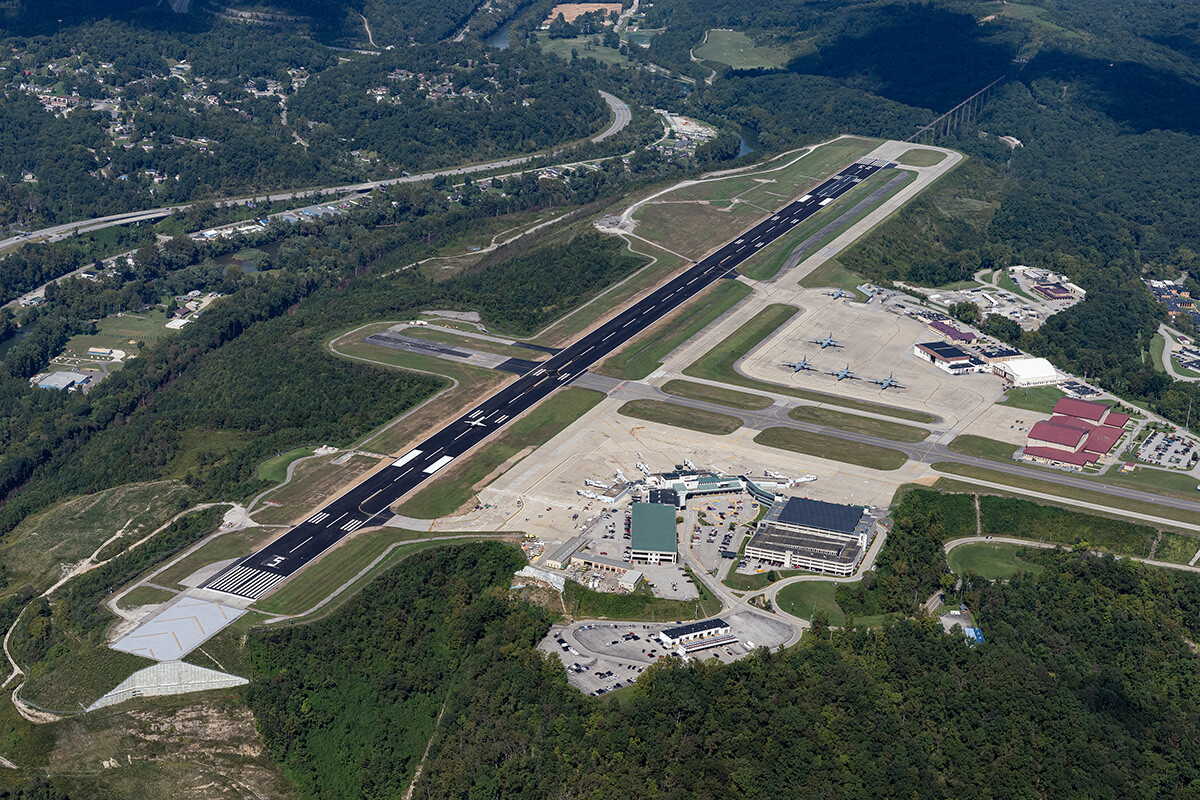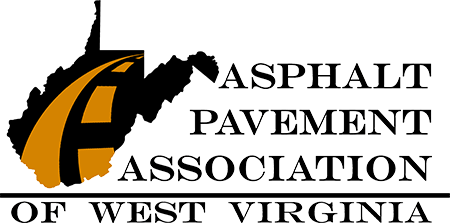72-Hours Till Departure Paving Against the Clock: Yeager Airport, Charleston WV

The Mid Atlantic’s Best Pavement Award is given to the top performing paving project completed the previous year between Maryland, Virginia, and West Virginia. This award investigates a single submission from each of the three states, rating them on the quality of materials, workmanship and complexity. In addition, subjective and objective measures are used to select the ultimate winner.
During the Mid-Atlantic Asphalt Expo and Conference in December, the inaugural 2023 Mid‑Atlantic’s Best Pavement was awarded to West Virginia Paving, Inc. from Dunbar, West Virginia for their work on the West Virginia International Yeager Airport Project, located in Charleston WV.
Project Overview
The West Virginia International Yeager Airport Runway 5-23 rehabilitation was a high-profile, fast-paced, time restricted project commissioned by the Central West Virginia Regional Airport Authority, completed in September 2022. The project spanned three contract packages, ultimately concluding with a complete structural overlay of the 150 by 6,500-foot runway, with between 2 and 4-inch of P-401 asphalt for which this award was given.
Responsible for all the paving operations across the three packages, West Virginia Paving, Inc., in 2020, milled and filled 3-inches on each outside 60-foot edges as well as reconstructing some isolated deep pavement. In 2021, WV Paving undertook the second phase, consisting of a mill and fill of 2-inches in the center 30-foot keel section as well as correction the elevation of roughly 5,100 feet of the runway surface. Finally in 2022, with the third phase, WV Paving placed the final mill and structural overlay of the runway, consisting of between 2-4 inches as well as replacing edge and guard lighting, grooving the runway, placing permanent pavement markings, and regrading soil in the runway safety areas.
Cumulative across all three contracts, WV Paving milled roughly 305,000 square yards and placed over 63,000 tons of P-401 asphalt. Much of the work across the first two phases was done either during night shifts where the airfield had to be opened at 6 AM for commercial traffic, however the final 150’ x 4700’ 2” mill and fill and the 150’ x 6250’, 2-inch overlay were placed during a single 72-hour window.
Yeager Airport
Originally called the Kanawha Airport, Yeager Airport opened for commercial service in December of 1947, after over 3 years of construction. In 1985, the airport was renamed after then-Brigadier General Chuck Yeager, a United States Air Force officer, flying ace, and record-setting test pilot. Chuck Yeager was born in 1923 and was a native of Lincoln County, WV and is well known for being the first pilot in history confirmed to have exceeded the speed of sound in level flight, accomplishing the task in October 1947 in a Bell X-1.
Yeager Airport sees an average of 100 flight operations per day: 63% general aviation, 13% air taxi, 15% military, and 9% airline. The airport also hosts the McLaughlin Air National Guard Base, home to eight C-130 Hercules aircraft of the West Virginia Air National Guard's 130th Airlift Wing, an Air Mobility Command gained unit of the West Virginia Air National Guard.
The Final Phase
The Yeager Airport rehabilitation projects were paved under the Federal Aviation Administration’s P-401 specifications, with the package three mill and fill and final overlay both utilizing Superpave 19-mm mixtures with a combination of course and fine limestone aggregates and a small fraction of natural sands. The mixtures were designed at 75 gyrations with a PG 64H-22 (PG 70-22). To meet the tight 72-hour time frame of the final paving, WV Paving utilized two local plants, located in Dunbar and Poca, WV, roughly 15 and 20-miles respectively from the airport. Each plant was dedicated to their own paving crews, which consisted of a materials transfer vehicle followed by a paver setup for 26-feet and three rollers performing compaction.
In front of the two pavers, WV Paving utilized four milling crews equipped with GPS and laser leveling systems to complete the roughly 123,000 square yards required to complete the 2-inch mill and fill section along with other areas and tie ins. All milling operations were completed in 16 hours. Following behind the milling, WV Paving utilizing an echelon paving operation was able to place the roughly 23,000 tons of asphalt materials in just 54 hours. The chosen operations not only helped WV Paving meet the strict time restraints, but it also reduced the number of longitudinal joints that had to be saw-cut, improving the overall joint quality and appearance. Ensuring the operation ran smoothly during both day and night shifts, WV Paving utilized a total of 85 trucks, 35 of which were dedicated to milling operations, with the remainder balanced between the two asphalt plants.
Not only was the final stages of the project severely time restrained, but it also required rigorous quality control checks throughout the production process, requiring 13 lots, consisting of 59 materials samples. In addition, between the milling and paving process, roughly 5250 survey points were taken to verify the elevation of the entire runway. A final survey was also taken after the completion of the overlay, revealing that the entire runway was within the specified ½” elevation tolerance. While profilograph roughness was not required, quality control (QC) data demonstrated that the runway had exceptional smoothness with an overall average International Roughness Index reading of 66.5 inches/mile. After paving was complete, the asphalt was required to cure before being grooved and permanently striped.
While Percent within Limits (PWL) can be a challenging specification, WV Paving came to this project well prepared, as the WV Division of Highways utilizes a similar specification on all its National Highway System routes. The FAA required that each lot’s pay factor be determined by taking the lowest computed pay factor based on either laboratory air voids and in-place density; all while meeting strict government specifications. Pay Factors for each lab air voids, and in-place density (mat and joint) were based on the statistical percentage of material within their given tolerances, which is calculated with the sample mean and standard deviation of the property. Air voids tolerances were between 2-5%, with the in-place mat density lower threshold was 92.8% theoretical maximum density (TMD), with joint cores being 90.5% TMD. Pay factors entered a deduction adjustment if the PWL of the property fell below 90. Total core counts for the runway were 88 (48 Mat and 40 joint) with none of the cores failing to meet the minimum thresholds, leading to an average in-place mat and joint density of 94.2% and 94.9% respectively.
This impressive feat could not have been accomplished without the roughly 250 people across eight companies working tirelessly to make sure the West Virginia International Yeager Airport had an excellent runway which will serve our community for years to come
Past Posts
The WVDOH announces its May Specifications Committee meeting, which is scheduled for Wednesday, May 7 at 9:00 a.m. at the WVDOH Building 5 Conference Room…
On Thursday evening April 17, following the vetoing of several line items, Gov. Patrick Morrisey signed into law a version of House Bill 2026, the…
The WVDOH was among 15 other Agencies across the country to earn honors for long-life asphalt pavements which deliver sustainable performance. Awarded annually by the…
Work Zone Awareness Week (WZAW) has been successful in spreading awareness for work zone safety across the country because of participation from organizations and individuals…
The WVDOH recently updated their policies, giving them the ability to accept e-notarizations when executing contract documents for projects awarded through Contract Administration Division for…
Update – April 17th, Governor Morrisey signed into law the 2026 state budget. See here for more details here. The West Virginia Legislature adjourned the…
The WVDOH announced an upcoming Materials Procedures (MP) Committee meeting. The meeting will be held in person on April 16 at 10:00 a.m. at the…
WVDOH has released the Asphalt, Concrete and Fuel price adjustment indices for the month of April 2025 as shown below.
Period – 4/1/2024
#2 Fuel (Gal) – $2.3297
Asphalt (Ton) – $579.00
Cement (Ton) – $195.28
Historical and individualized information can be found on our Index page.
Even with a winter storm that moved eastward over the area, nearly 200 individuals from industry, WVDOH, and academia joined together for the 45th Annual…
APAWV received a letter dated March 4, 2025 from the West Virginia Division of Highway’s materials division recently regarding Contractor’s responsibility to initiate and enter…
